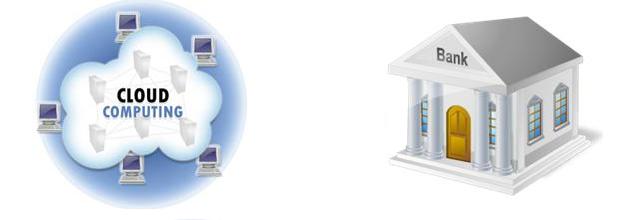Banks Open Doors For Cloud Computing
 Studies now indicate that about 75% of banking organizations will use Enterprise Cloud Computing, or hybrid solutions for cloud computing.
Studies now indicate that about 75% of banking organizations will use Enterprise Cloud Computing, or hybrid solutions for cloud computing.
The technology resource with elements of applications, processors, storage capacity and data center in a cloud on the Internet, has also became a key theme and will be much discussed in the financial and insurance sectors. In India, data center providers are expanding their investments in infrastructure to meet the new wave, while IT executives, who confirmed to be not going back, argue that the application that is most appropriate and safe at this moment is a public cloud, private cloud or hybrid cloud.
The year 2012 will undoubtedly be the year where Cloud Computing will take the first steps to the movement that actually will become a reality in organizations. Outside India, the emerging trend, driven mainly by the advantage of cost savings, according to experts, it is the logical evolution in the banking sector. Studies now indicate that about 75% of banking organizations will use enterprise cloud computing, or hybrid cloud computing solutions, which implies the existence of a private cloud and through other means which are more open, in which any employee could have access.
The main issue, even debated in international forums is, “Is the Cloud hosting solution a valuable hedge for banks?” And the answer is “Yes“. In ’70s and ’80s, financial institutions already had a central computer, such as a mainframe terminal, whose main advantage was the saving of time, it was possible to keep all data centralized. The big difference is that, the cloud computing today relies on the fact that the information ends up being “hung” in the cloud.
The contribution that cloud computing can bring to the banking sector is very high. And beneficial as well. The main one is the flexibility that this technology can provide to the banks. In addition to allowing, among other benefits, “pay per use“, that is, offer a way to measure and manage the service network of computers in a more efficient and flexible way, the model will allow the bank to establish its variable costs and adjust their own real needs within their gains, the number of clients, etc..
Cloud Computing provides a model in which the payment is linked to the service that is used, it helps to increase or decrease capacity utilization. This new structure makes the planning of the different departments in a condition that is more flexible and agile, this is another added advantage.
For now, this trend began to take its first steps, especially because today, even if they have noticed the need for migration to this type of technology, there remain some issues to resolve before putting the whole process into practice. The need for legislation and regulation to adjust and establish how to act in case of catastrophe or disaster, which protocol is most appropriate at certain times or will be subject to audits. It is difficult to ensure that the banking sector will use a cloud computing which is open and transparent.
Hence, the service providers are investing all their efforts and financial resources to provide a flexible means of the use of internal and external solutions.
The more the confidence, the greater the opportunity to use private means that are based on two core values: integrity and availability of information privacy, two prerequisites for the confidentiality of user data is not lost, regardless of the technology.
- How Cloud Computing Is Changing The Labor Market - March 25, 2015
- Adopting Infrastructure as a Service Can be a Good Deal - March 17, 2015
- Will Virtualize? Take These Six Points Into Consideration - March 12, 2015